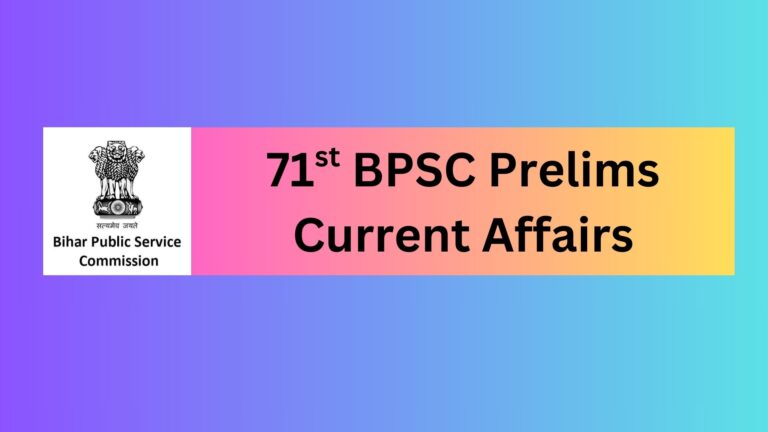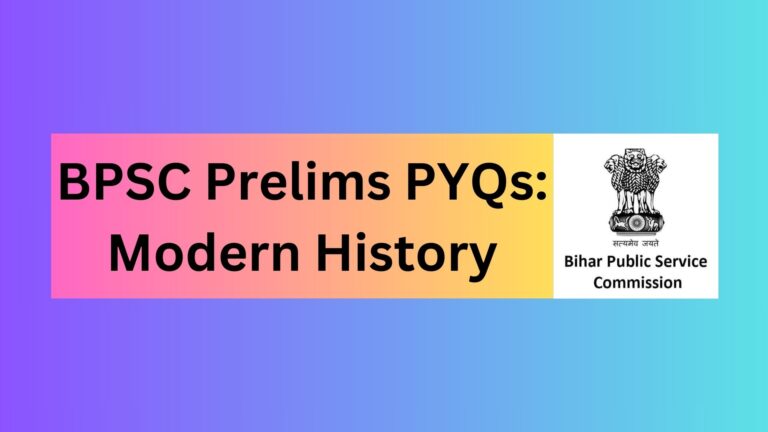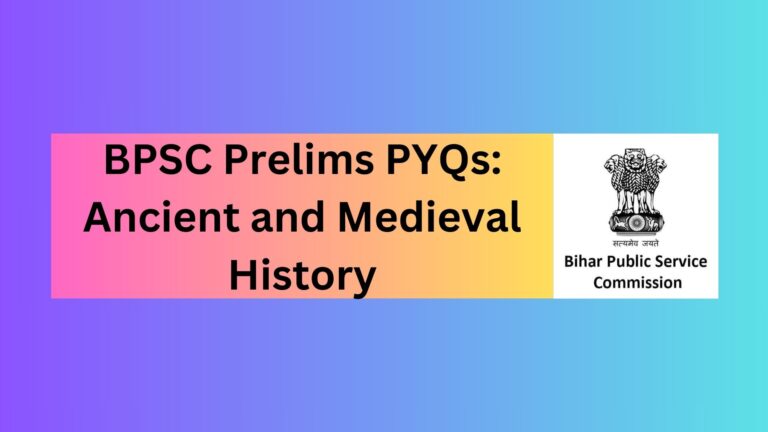
Modern History and Art & Culture is an essential part of BPSC Mains General Studies Paper I, assessing candidates’ understanding of key historical events, figures, and movements. Analyzing previous year questions (PYQs) allows aspirants to identify important topics. This helps candidates focus on key themes and prepare effectively for the exam, ensuring a strong grasp of historical developments that influence present-day governance and society.
Syllabus: Modern History of India and Indian Culture will cover the broad history of the country (with special reference to Bihar) from about the middle of nineteenth century. The modern history of Bihar will include questions on the introduction and expansion of western education (including technical education). It will also have questions on Bihar’s role in the freedom struggle of India. Questions will relate to the Santhal Uprising, 1857 in Bihar, Birsa movement, Champaran Satyagrah and the Quit India Movement 1942. A knowledge of the chief features of Mauryan and Pal art and Patna Qulam painting will be expected from the examinees. It would also include questions or Gandhi, Tagore and Nehru.
Also Read: BPSC Prelims + Mains Syllabus
70th BPSC Mains
Short Questions (All Questions were Compulsory) (38 Marks)
1. Indian Councils Act 1861 (8 Marks)
2. Role of Bihar in the Quit India Movement (8 Marks)
3. Santhal Uprising (8 Marks)
4. Patna Kalam Painting (7 Marks)
5. Art and Architecture of Mauryan Age (7 Marks)
Long Questions (Both Questions are compulsory)
1. Describe the Champaran Indigo Movement and explain its impacts on the Indian Freedom Struggle (38 Marks)
or
How far the British Policy was responsible for the emergence of Indian National Movement? Explain (38 Marks)
2. Examine the expansion of Western Education in Bihar from mid-nineteenth century onward. (38 Marks)
or
Assess the constructive works of Mahatma Gandhi (38 Marks)
69th BPSC Mains
Short Questions (All Questions were Compulsory) (38 Marks)
- Indian Councils Act 1892 (8 Marks)
- Santhal Uprising (8 Marks)
- Champaran Satyagraha (8 Marks)
- Art and Architecture of Mauryan Period (7 Marks)
- Cave Paintings of Eastern India in Ancient Period (7 Marks)
Long Questions (Both Questions are compulsory)
1. “Bihar has been the centre of learning and spiritualism for ancient time”. Explain in detail (38 Marks)
or
Evaluate the Champaran Indigo Movement and explain its impacts on the Indian Freedom Struggle. (38 Marks)
2. Critically examine the contribution of moderate phase of the Indian National Congress Movement. (38 Marks)
or
Trace the development of modern education in Bihar and its impact. (38 Marks)
68th BPSC Mains
Short Questions (All Questions were Compulsory) (38 Marks)
- Government of India Act, 1858 (8 Marks)
- Birsa Munda Movement (8 Marks)
- Indigo Revolt (8 Marks)
- Patna Kalam Painting (7 Marks)
- Development of Caves in Eastern India in Ancient Time (7 Marks)
Long Questions (Both Questions are compulsory)
1. Discuss the factors for the emergence of Indian National Movement. How it gave direction to the Indian Freedom Struggle. (38 Marks)
or
Discuss the growth of colonial technical education in Bihar under various schemes of British Rule. Critically analyze its impact. (38 Marks)
2. Analyze the development of temples in North India in ancient times. (38 Marks)
or
Describe Rabindranath Tagore’s ideas of society and cultures. (38 Marks)
67th BPSC Mains
Candidates had to attempt three questions. (Each Question was of 38 Marks)
- Discuss the factors responsible for the formation of Indian National Congress. What were the British Policies towards early nationalists?
- Trace the course of expansion of Western and technical education in Bihar between 1857-1947.
- Critically analyze the factors responsible for the emergence of Gandhi as an eminent nationalist leader.
- Write an essay on the Quit India Movement of 1942. Was it a spontaneous movement?
- Describe the chief characteristics of Mauryan Art.
- Write short notes on any two of the following: (a) Santhal Uprising (b) Champaran Satyagraha (c) Rabindranath Tagore’s Contribution to the Freedom Movement
66th BPSC Mains
Candidates had to attempt three questions. (Each Question was of 38 Marks)
- What were the causes of Santhal Revolt? What were its course and outcome?
- Examine the characteristics of the Birsa Movement.
- Bring out the main features of the Patna Kalam Painting.
- “Champaran Satyagraha was the watershed in the Freedom Struggle”. Explain.
- Discuss Nehru’s views on Communalism and Secularism.
- Write Short Notes on any two of the following: (a) Gandhiji’s Views on Satyagraha (b) Jayprakash Narayan and the Quit India Movement (c) Subhash Chandra Bose and the INA
65th BPSC Mains
Candidates had to attempt three questions. (Each Question was of 38 Marks)
- What were the causes of the Revolt of 1857? What effect did it have on Bihar?
- Discuss the spread of western education in Bihar between 1858-1914.
- Write a note on Swami Sahjanand and the Kisan Sabha Movement.
- Explain the social and economic ideas of Ram Manohar Lohia and Jayprakash Narayan.
- Discuss the features of Pala art and architecture and its relationship with Buddhism.
- Write short notes on any two of the following: (a) Dr Rajendra Prasad and the National Movement (b) Gandhiji’s views on caste and religion (c) The Dalit Movement in Bihar
64th BPSC Mains
Candidates had to attempt three questions. (Each Question was of 38 Marks)
- Critically examine the evolution of Indian Nationalism since the late 19th century.
- “Champaran Satyagraha was the watershed in the Freedom Struggle”. Elucidate.
- What were the reasons behind overseas immigration in the 19th century British India? Discuss in the light of the indenture system with special reference to Bihar.
- Examine the characteristics of tribal protest in the 19th century with suitable examples. Give reasons for their failure.
- Discuss the features of Mauryan art and architecture and its relationship with Buddhism.
- Write short notes on any two of the following: (a) Working Class and National Movement (b) Impact of Census of 1881 on caste and religious identities (c) Nehru and Secularism
63rd BPSC Mains
Candidates had to attempt three questions. (Each Question was of 38 Marks)
- Describe the significance of Gandhiji’s social and cultural thoughts.
- Discuss the contribution of Bihar to the uprising of 1857 AD.
- Evaluate the causes and results of Revolt of Santhal (1855-56) in Bihar.
- Discuss the development of western education in Bihar from 1857 AD to 1947 AD.
- Describe causes and results of Champaran Satyagraha in Bihar (1917)
- Examine the salient features of Patna Kalam Painting Style.
60th-62nd BPSC Mains
Candidates had to attempt three questions. (Each Question was of 38 Marks)
- Describe the people’s participation in Bihar during the Quit India Movement of 1942.
- Discuss the development of Western Education in Bihar from 1813 to 1947.
- Throw light on Mauryan Art and analyze its impact in Bihar.
- “Gandhi’s mystique consisted of a union of original ideas with a remarkable flair for tactics and an uncanny insight in the mass mind”. Elucidate.
- Evaluate the contribution of Rabindranath Tagore in Bengali literature and music.
- Examine the main features of Foreign Policy of Jawaharlal Nehru.
56th-59th BPSC Mains
Candidates had to attempt three questions. (Each Question was of 38 Marks)
- Critically examine the significance of the Revolt of 1857 with special reference to Bihar.
- Discuss the main causes of the Santhal Uprising. What were its consequence?
- Bring out the salient features of the Patna Kalam Paintings.
- What were the significance of Champaran Satyagraha for Peasant Uprisings.
- Define Nationalism. How was it addressed by Rabindranath Tagore?
- Discuss the relevance of Nehru in the making of modern India.
53rd-55th BPSC Mains
Candidates had to attempt three questions. (Each Question was of 38 Marks)
- Critically examine the role of Kunwar Singh in the Revolt of 1857.
- “The underlying object of the Birsa Movement was internal purification and the desire to remove the alien government.” Explain.
- Describe the contribution of Bihar in the individual satyagraha of 1940-41.
- Discuss the salient features of the Mauryan Art.
48th-52nd BPSC Mains
Candidates had to attempt three questions. (Each Question was of 38 Marks)
- Describe the social and cultural significance of the ideas of Rabindranath Tagore.
- Describe the contributions of Bihar to the Quit India Movement of 1942.
- Discuss the causes and results of Revolt of Santhals (1855-56) in Bihar.
- Discuss the salient features of Patna Kalam & painting style.
Also Read: BPSC Mains PYQs Subject Wise
Follow Fusion IAS


